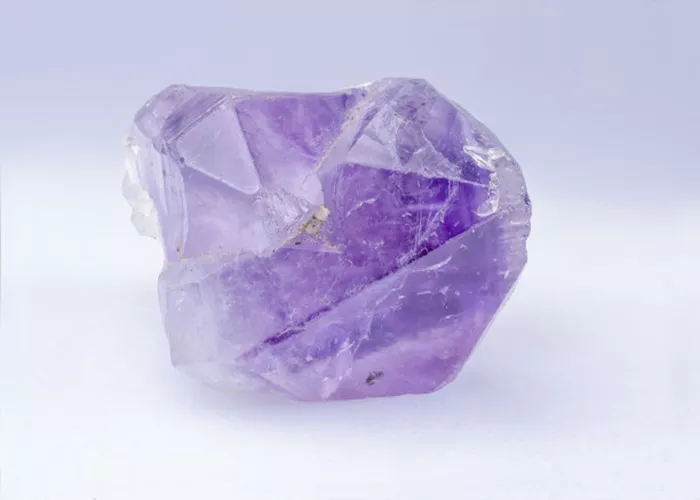In the vast world of gemstones, amethyst holds a unique position, known for its enchanting purple hues and mystical aura. Among the various forms of amethyst jewelry, the amethyst stalactite flower article stands out as a masterpiece of nature and craftsmanship. This article aims to provide a detailed introduction to this fascinating gemstone creation, exploring its origins, characteristics, production processes, cultural significance, and appreciation tips.
Origins and Characteristics of Amethyst Stalactite Flowers
Amethyst, a variety of quartz, derives its name from the Greek word “amethystos,” meaning “not drunken.” Ancient Greeks believed that wearing amethyst could prevent intoxication, making it a symbol of sobriety and wisdom. The purple color of amethyst ranges from light lavender to deep violet, often displaying a beautiful gradient effect. This color is caused by trace elements such as iron and aluminum in the quartz crystal structure, which absorb certain wavelengths of light and reflect others, creating the unique purple hues.
Stalactites, on the other hand, are geological formations commonly found in caves. They form when water containing dissolved minerals drips from the cave ceiling, gradually depositing minerals over time to create elongated, cone-shaped structures. When amethyst crystals grow in a similar manner, forming elongated, branch-like structures, they are referred to as amethyst stalactites.
Combining the beauty of amethyst with the unique shape of stalactites, jewelers have crafted the amethyst stalactite flower article. These pieces often feature intricate, branch-like structures with flowers or buds blooming at the ends, resembling the natural beauty of stalactites but with a touch of artistic refinement.
Production Processes of Amethyst Stalactite Flower Jewelry
Creating an amethyst stalactite flower article involves a series of meticulous steps, blending natural beauty with human craftsmanship.
Mining and Selection: The first step is to mine high-quality amethyst crystals. Miners carefully extract the crystals from their natural environment, ensuring minimal damage. Once extracted, jewelers select the best crystals for stalactite flower production, focusing on those with vibrant colors and clear crystal structures.
Cutting and Shaping: The selected crystals are then cut and shaped into the desired stalactite form. This process requires skilled craftsmanship and precision, as even minor errors can affect the final appearance. Jewelers use specialized tools to carve out the branch-like structures and create the buds or flowers at the ends.
Polishing: After cutting and shaping, the pieces undergo a polishing process to enhance their shine and smoothness. This step is crucial for showcasing the natural beauty of amethyst and ensuring a comfortable wearing experience.
Setting: Finally, the polished stalactite flowers are set into jewelry pieces such as pendants, earrings, or brooches. The setting process involves attaching the flowers to a metal base using techniques such as prong setting or channel setting, ensuring they are securely held in place.
Cultural Significance of Amethyst Stalactite Flower Jewelry
Amethyst has held a special place in various cultures throughout history, often associated with royalty, spirituality, and protection. The purple color is seen as a symbol of luxury, wisdom, and power, making amethyst a popular choice for royal jewelry.
In ancient Greece, amethyst was believed to protect wearers from the intoxicating effects of alcohol and was often worn by soldiers and sailors to ensure clear judgment during battles and voyages. The Romans also revered amethyst, believing it had the power to ward off evil spirits and promote sobriety.
The stalactite shape, with its roots in natural geological formations, adds an element of earthiness and connection to the natural world. The combination of amethyst and stalactite flowers in jewelry pieces thus symbolizes a harmony between the natural and the artificial, the mystical and the practical.
In modern times, amethyst stalactite flower jewelry continues to be popular, not only for its aesthetic appeal but also for its cultural significance. Many people believe that wearing amethyst can bring wisdom, calmness, and protection, making it a perfect choice for those seeking inner peace and strength.
Appreciation Tips for Amethyst Stalactite Flower Jewelry
Appreciating amethyst stalactite flower jewelry involves more than just admiring its beauty. Here are some tips to help you fully appreciate this unique gemstone creation:
Observe the Color: Amethyst’s purple hues can vary greatly, from light lavender to deep violet. Pay attention to the color saturation and gradient effect, as these factors contribute to the overall beauty of the piece.
Examine the Clarity: Like other gemstones, amethyst can contain inclusions such as cracks, bubbles, or other impurities. A clearer piece will typically have a higher value and appear more visually appealing.
Assess the Cut and Shape: The cut and shape of the stalactite flowers are crucial for showcasing the gemstone’s beauty. Look for pieces with well-defined branch-like structures and flowers that are evenly proportioned and symmetrical.
Consider the Setting: The metal base and setting style can also affect the overall appearance and value of the jewelry piece. Choose a setting that complements the color and shape of the amethyst stalactite flowers, enhancing their natural beauty.
Learn About the History and Culture: Understanding the history and cultural significance of amethyst stalactite flower jewelry can add an extra layer of appreciation. Research the origins of amethyst, its role in various cultures, and the meaning behind the stalactite shape to gain a deeper understanding of this unique gemstone creation.
Conclusion
Amethyst stalactite flower jewelry is a masterpiece of nature and craftsmanship, combining the beauty of amethyst with the unique shape of stalactites. Its production involves meticulous steps, blending natural beauty with human skill. Culturally, amethyst holds special significance, symbolizing wisdom, power, and protection. To fully appreciate this gemstone creation, observe its color, clarity, cut, and setting, and learn about its history and cultural background. Whether worn as a personal accessory or displayed as a work of art, amethyst stalactite flower jewelry continues to captivate hearts and minds with its mysterious beauty and enchanting charm.
Related topic:
- How Hard Wearing Is Amethyst
- Best Crystals to Pair with Amethyst
- Can a Carved Amethyst Necklace Enhance Your Spiritual Well-being?


